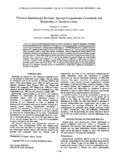Pyroxene spectroscopy revisited: Spectral-compositional correlations and relationship to geothermometry.
Metadata
Show full item recordAuthor
Cloutis, Edward A.
Gaffey, Michael J.
Date
1991-12-25Citation
Cloutis, E. A., and M. J. Gaffey. "Pyroxene spectroscopy revisited: Spectral-compositional correlations and relationship to geothermometry." Journal of Geophysical Research, 96 (1991): 22,809-22,826. DOI: 10.1029/91JE02512.
Abstract
Pyroxene reflectance and transmittance spectra have been examined in a search for systematic relationships between spectral features and compositional variations and to assess the applicability of reflectance spectroscopy to pyroxene geothermometry. Orthopyroxenes containing up to ~11% Wollastonite show a positive correlation between Fe2+ content and wavelength positions of the major absorption bands. Aluminum-rich orthopyroxenes display absorption bands at lower than expected wavelengths. Spectral-compositional relationships are more complex for clinopyroxenes, showing both positive and negative correlations between band positions and major cation abundances. These relationships are further complicated by the presence of significant amounts of other transition series elements such as Ti and Cr and by the presence of exsolved phases and compositional zonations. Even small-scale exsolutions ( < 1 μm wide) seem to be sufficient to significantly alter spectral properties. Contours of the wavelength positions of band minima projected onto the pyroxene tetralateral generally exhibit concave downward shapes. The orientations of the contours relative to pyroxene geotherms are such as to effectively preclude the use of spectroscopy to significantly constrain the temperatures of formation of pyroxenes.

